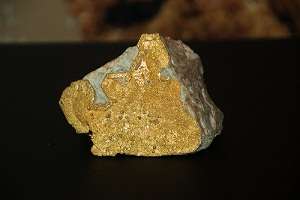Improving the hunt for gold

A geologist is using conditional probability principles to improve the design of nuggetty gold mines.
CSIRO's Dr June Hill says nuggetty deposits may be rich in chunks of gold that are spaced so far apart that a diamond drill misses them, and they do not show up in core samples.
"You underestimate the resource because you miss a lot of the gold," she says.
To compensate for the lack of gold in the assay, geologists may then infer the presence of gold, using rock with certain characteristics as a proxy.
"They have to understand how the deposit formed to understand how the proxies are important," she says.
"When the gold is introduced into the rock it comes in fluid.
"The fluids alter the rocks.
"Also you typically get deformation.
"You might get faulting, shearing, that sort of thing.
"You get alterations and veins around where you get gold deposited."
The owners of Sunrise Dam mine near Kalgoorlie asked the CSIRO to produce a three dimensional model of the resource.
"We wanted to automate that process because there was a big drill hole database and they'd only started coding the proxies in the drill hole database quite recently," Dr Hill says.
"The other problem was that for different parts of the mine they found that the things that indicated gold were different.
"And they only had one coding scheme so it wasn't flexible enough for them to move around different parts of the mine where there were subtle differences."
She developed a method using probability estimation to log various known characteristics associated with gold mineralisation in the mine.
"All that information was available in the database," she says.
"It was just a matter of automatically looking at how often you get high gold values associated with different features and just assigning a probability value to that."
Dr Hill says the principal is widely used in medicine, but had never been applied to gold mineralisation in geology.
She likens it to a positive test for cancer, which may not be 100 per cent definitive.
"They'll say 'what is the probability you'll have cancer?'—which is usually a much lower probability," she says.
"It's called conditional probability because the idea is that you are conditioning the probability on the features."
The result has been a series of three-dimensional images of the gold resource.
She is now working to further refine the model using geochemistry values.
More information: "Characterisation and 3D modelling of a nuggety, vein-hosted gold ore body, Sunrise Dam, Western Australia," Evelyn June Hilla, Nicholas H.S. Oliverb, James S. Cleverleya, Michael J. Nugusc, John Carswell, Fraser Clarkc. Journal of Structural Geology, Available online 6 November 2013, ISSN 0191-8141, dx.doi.org/10.1016/j.jsg.2013.10.013
Journal information: Journal of Structural Geology
Provided by Science Network WA




















